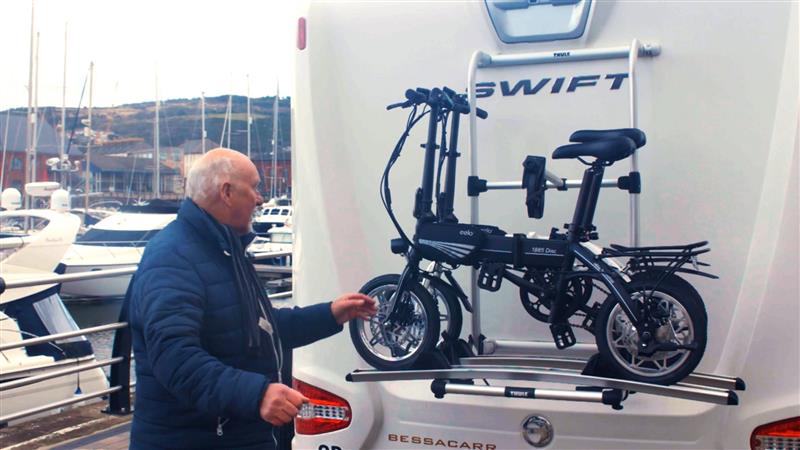In the fast-paced urban landscapes of the United Kingdom, commuting has become synonymous with challenges like traffic congestion, air pollution, and limited accessibility. As cities grow and populations increase, the need for sustainable and efficient transportation solutions becomes more pressing than ever.
In recent years, the combination of foldable e-bikes and public transportation has emerged as a promising answer to these challenges, offering commuters a seamless and eco-friendly way to navigate city streets. Let’s explore the benefits, innovative technologies, and practical strategies for integrating e-bikes and public transportation into everyday commuting routines.

Understanding E-Bikes
Electric bicycles, or e-bikes, have a rich history dating back to the late 19th century. From early prototypes to modern-day marvels, the evolution of e-bikes reflects advancements in technology, design, and sustainability. This section delves into the origins of e-bikes, tracing their development from basic pedal-assist models to sophisticated electric propulsion systems.
The appeal of e-bikes extends far beyond their novelty factor. In addition to providing an efficient mode of transportation, e-bikes offer many benefits for riders and communities alike. This section examines the advantages of e bike ride, including their environmental impact, health benefits, cost savings, and convenience factors. By leveraging the power of electric propulsion, e-bikes empower riders to commute confidently and easily.
Environmental Impact
E-bikes are environmentally friendly alternatives to traditional vehicles, as they produce zero emissions during operation. By reducing reliance on fossil fuels and minimising air pollution, e-bikes contribute to cleaner and healthier urban environments. Their low carbon footprint makes them a sustainable transportation option, aligning with efforts to combat climate change and preserve natural resources.
Health Benefits
Riding an e-bike provides an excellent form of physical activity, offering cardiovascular exercise and muscle engagement without the high impact of other activities like running or weightlifting. Whether used for commuting or leisurely rides, e-bikes promote active lifestyles and improve overall fitness. Additionally, e-biking can be particularly beneficial for individuals with mobility limitations or those looking to increase their activity levels gradually.
Cost Savings
E-bikes offer significant cost savings compared to owning and operating a car. With lower upfront costs, reduced maintenance requirements, and minimal fuel expenses, e-bikes represent a more affordable mode of transportation over the long term. Commuters can save money on fuel, parking fees, and vehicle maintenance, making e-bikes an attractive option for budget-conscious individuals and families. Additionally, some jurisdictions offer incentives or subsidies for e-bike purchases, further enhancing their affordability and accessibility.

Public Transportation in the UK
The United Kingdom boasts a comprehensive network of public transportation systems, including buses, trains, trams, and ferries. Public transit connects communities and facilitates mobility, from bustling metropolises like London to picturesque rural villages.
While public transportation offers numerous benefits, it also faces overcrowding, delays, and infrastructure limitations. Here are the key challenges facing public transit systems in the UK, and potential strategies for overcoming them are examined.
From investment in infrastructure upgrades to integrating emerging technologies, there are opportunities to enhance the efficiency, accessibility, and sustainability of public transportation across the country.
Overcrowding
One of the primary challenges facing public transit systems in the UK is overcrowding, particularly during peak hours in densely populated urban areas. Overcrowded buses, trains, and platforms inconvenience passengers, pose safety risks, and decrease overall satisfaction with public transportation services.
However, this challenge presents an opportunity to invest in capacity expansion and frequency improvements. By increasing the number of vehicles, adding additional routes, and optimising schedules, transit agencies can alleviate overcrowding and enhance the overall passenger experience.
Delays
Delays are another common issue plaguing UK public transportation systems, resulting from mechanical failures, signal failures, track maintenance, and inclement weather. Delays inconvenience passengers and undermine the reliability and efficiency of public transit services.
To address this challenge, there is an opportunity to invest in modernisation and maintenance initiatives. Transit agencies can minimise delays and improve service reliability by upgrading ageing infrastructure, implementing predictive maintenance technologies, and enhancing communication systems.
Infrastructure Limitations
Public transportation infrastructure limitations, such as insufficient capacity, outdated facilities, and accessibility features, pose significant challenges for passengers and operators. These limitations can hinder expanding and improving public transit networks, limiting their effectiveness in serving growing populations and evolving mobility needs.
However, there is an opportunity to invest in infrastructure upgrades and expansion projects. By building new transit lines, upgrading existing stations, and implementing universal design principles, cities can create more inclusive, efficient, and accessible public transportation systems that better meet the needs of all passengers.

The Power of Integration
Combining e-bikes with public transportation allows commuters to enjoy a seamless and sustainable commuting experience. This section explores the synergies between e-bikes and public transit, highlighting their complementary strengths and capabilities. From extending the reach of transit networks to reducing congestion and emissions, integrated commuting solutions offer numerous benefits for individuals and communities.
Enhanced Connectivity
Integrating e-bikes with public transportation networks improves connectivity by providing first and last-mile solutions. Commuters can use e-bikes to bridge the gap between their homes, workplaces, and transit stations, seamlessly connecting different modes of transportation. This enhanced connectivity increases accessibility, especially for individuals living in areas with limited transit options or lacking convenient station access.
Reduced Commute Times
E-bikes enable commuters to navigate congested urban environments more efficiently, avoiding traffic delays and reducing overall commute times. By incorporating e-bikes into their multimodal journeys, commuters can bypass traffic congestion, access dedicated bike lanes, and choose optimal routes. This results in faster and more reliable travel, ultimately improving commuters' productivity and quality of life.
Cost Savings
Combining e-bikes with public transportation offers cost-effective commuting solutions for individuals and communities. E-bikes have lower operating costs than traditional vehicles, requiring minimal maintenance and no fuel expenses. By using e-bikes in conjunction with public transit, commuters can reduce reliance on costly car ownership, save money on fuel and parking fees, and enjoy affordable and sustainable transportation alternatives.
Health and Fitness Benefits
Integrating e-bikes with public transportation promotes active lifestyles and improves general health outcomes. Cycling is an excellent, low-impact exercise, offering cardiovascular benefits, muscle strengthening, and stress reduction. By encouraging commuters to incorporate cycling into their daily routines, integrated transportation systems contribute to healthier communities, reduce healthcare costs, and improve overall well-being.
Environmental Sustainability
E-bikes and public transportation integration support environmental sustainability goals by reducing carbon emissions and mitigating air pollution. E-bikes produce zero emissions during operation, making them eco-friendly alternatives to cars and motorcycles. Cities can decrease reliance on fossil fuels, alleviate traffic congestion, and promote cleaner and greener urban environments for present and future generations.

Conclusion
As cities grapple with urbanisation and environmental degradation challenges, integrating e-bikes and public transportation offers hope for a more sustainable future. By embracing innovative technologies, fostering collaboration, and prioritising active transportation solutions, cities can create healthier, more livable urban environments for all.
E-bikes and public transportation represent more than just modes of travel; they symbolise a transformative shift towards cleaner, greener, and more inclusive cities. By embracing this vision and working together towards common goals, we can build a brighter future for future generations.
Please contact us promptly if you are considering purchasing a new folding e-bike but are still deciding which type to buy. Happy riding!

